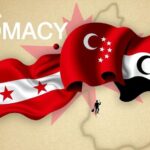Conflicts
AHMED AL - SHARAA, ASIA, AZAZ, BASHAR AL - ASSAD, CIVIL WAR, CONFLICT, EUROPE/ASIA, FREE SYRIAN ARMY, GLOBAL JIHAD, GOVERNMENT, MOHAMMED AL - BASHIR, MOHAMMED AL - JOLANI, NORTH AMERICA, REFUGEE CRISIS, REFUGEES, SHA, SYRIA, SYRIAN CONFLICT, SYRIAN SALVATION, TERRORISM, TURKEY, UNITED, UNITED STATES
Nia Simpson
Who Will Control Syria Following the Collapse of Assad’s Regime?
The potential collapse of Bashar al-Assad’s regime has left a power vacuum in Syria, with several factions vying for control. Hayat Tahrir al-Sham (HTS) is the most dominant group in western Syria, while the Southern Operations Room and the Syrian National Army continue to operate in the south and northwest, respectively. The Kurdish-led Syrian Democratic Forces hold the northeastern region, and foreign powers maintain military presences throughout the country, leaving Syria’s future uncertain.
As the Syrian civil war enters a new phase following the anticipated collapse of Bashar al-Assad’s regime, several key factions are emerging as potential powerholders in the fragmented landscape. The most formidable of these is Hayat Tahrir al-Sham (HTS), which governs much of western Syria under the leadership of Abu Mohammed al-Jolani. HTS has rebranded itself as a more moderate entity, although it remains internationally designated as a terrorist group due to its past affiliations and ongoing human rights violations.
In southern Syria, the Southern Operations Room presents a diverse coalition of secular and Islamist factions, alongside Druze militias. Initially reconciling with Assad’s government, these groups have united again to oppose the regime amid increasing pressures from HTS. Meanwhile, the Syrian National Army (SNA) continues to retain control in the northwest, receiving direct backing from Turkey and often clashing with Kurdish-led forces, particularly the Syrian Democratic Forces (SDF).
The SDF, governing northeastern Syria, comprises mainly Kurdish fighters and diverse Arab and minority militias. Although admired for its democratic principles, the SDF also faces accusations of collaborating with the Assad regime. The Islamic State (IS), albeit significantly weakened, remains active through terrorism, while foreign powers, including the United States and Russia, retain strategic military footholds in the country.
Amid these complex dynamics, Israel has declared control over a demilitarized buffer zone in southern Syria for security purposes. The myriad factions’ engagements in the political landscape will play a critical role in determining Syria’s future governance and social stability as citizens hope for an amicable resolution to the conflict that has ravaged their nation for over a decade.
Syria has been embroiled in a protracted civil war since 2011, characterized by intricate alliances and conflict between various armed groups. The war saw an initial uprising against President Bashar al-Assad, which spiraled into a multi-faceted conflict involving local and international players. Each faction’s shifting ideologies and alliances have led to a fragmented governance structure in Syria, with power now concentrated in the hands of several key entities following the anticipated demise of Assad’s regime. The ongoing conflict not only raises questions about future leadership but also about how various factions will forge relationships moving forward, potential governance systems, and the sociopolitical landscape in a post-Assad Syria.
In conclusion, Syria’s future governance landscape remains unpredictable following the potential collapse of Bashar al-Assad’s rule. Hayat Tahrir al-Sham stands poised to exert significant influence over western Syria, while rival factions such as the Southern Operations Room and the Syrian National Army maintain territorial control in their respective regions. The role of the Syrian Democratic Forces and the prevailing influence of foreign powers further complicate the situation. Ultimately, the resolution of this complex conflict will depend on the factions’ ability to negotiate and establish a cooperative governance structure that addresses the populace’s needs for stability and peace.
Original Source: www.voanews.com








Post Comment